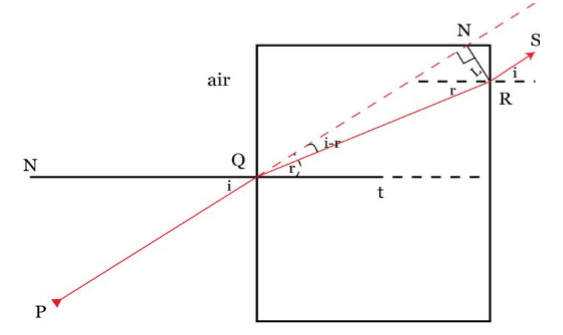Refraction Through Slab
Description:
Slab is cuboid shaped object made-up of glass. When a ray of light passes through a slab it interacts with 2 refracting surfaces.
As slab is made-up of glass, when the light ray is entering the slab it has to travel from rarer medium (air) to denser medium (glass slab), this results in bending of ray towards the normal and when the light ray leaves the slab it moves from denser medium to rarer medium resulting in bending of light away from the normal.
After the two refractions the resulting ray has the same direction as that of the incident ray on the slab.
The resultant effect of refraction when ray passes through the slab is lateral displacement i.e. there is no change in direction of the ray but the path of the incident ray and refracted ray are different and parallel to each other.
To calculate the lateral displacement, a perpendicular is drawn in between the paths of incident ray and refracted ray as shown in figure.

From figure −
L = RN = QR sin(i-r)
Observations
Lateral displacement depends upon the thickness of the slab, thicker will be the slab, grater will be the lateral displacement.
Greater the value of angle of incident, grater will be the lateral displacement.
Note − The lateral displacement of thin slab is so small that it can be neglected and we can consider that there is no lateral displacement of light ray when it passes through thin slab.

